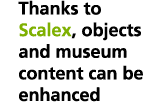The second Model Exhibition was planned and successfully realized by the ZKM in Karlsruhe together with the other consortium members. The exhibition was installed in the permanent exhibition area of the Media Museum in the period March, 31 to May, 2nd 2004 and could be used there by all museum visitors.
The second Model Exhibition was focusing on using personal digital assistants (PDAs) for personalised adaptive presentation of multimedia content about the exhibition objects. The PDAs were offered by the museum and visitors could use them to explore the content of the second Model Exhibition. For people not using a PDA two touch screen kiosk were set up so that these visitors could also browse the information space.
The content of the exhibition was related to concrete exhibits from the public collection in the Media Museum of ZKM. The topic “From Panorama to Virtual Reality” derived from a curatorial selection of 5 art works, in particular, 5 interactive media art installations, its immanent features of illusion and immersion with the typical architecture and visual form of the Panorama. The Panorama as such is seen both as a technological structure of visual presentation and as a historical entertainment and art object.
Moreover the former head of the largest institute of ZKM, the Institute of Visual Media, the Australian born artist, Jeffrey Shaw has in its artistic work always focused on new ideas of panoramic visual re-presentation. Inventions such as the “EVE (Extended Virtual Environment)”, from 1993, a balloon like projection structure of nearly 360° degrees, and other works are significant for his relation to the topic of Panorama.
But the art works are not just a re-edition of the historic panorama but emerged through a further technological development of the aspects of immersion and illusion to the realization of the phenomenon of Virtual Reality. All 14 selected art works had strong relations to either the concept of Panorama or the concept of Virtual Reality, or both. Therefore the exhibitition presented a thematic tour through a selected group of works in the Media Museum of ZKM focused on the topic ‘From Panorama to Virtual Reality’. Within the virtual guided tour through the permanent exhibition 5 real art works and 9 referential works are introduced to the visitor. These 14 media art installations have either been produced at the ZKM, or previously exhibited at the ZKM.
Jeffrey Shaw: Place – Ruhr, 2000; Place Urbanity, 2002 Eve (Extended Virtual Environment), 1993 ConFiguring the Cave, 2001 The Legible City, 1988-1991 The Virtual Museum, 1991 Luc Courchesne: The Visitor: Living by Number, 2001 Luc Courchesne: The Visitor: Living by Number, 2001 Maurice Benayoun: So.So.So ( Somebody, Somewhere, Sometime) , 2002 Michael Naimark: Be Now Here, 1995 – 1997 Masaki Fujihata: Fieldwork @ Alsace, 2002
The visitor is offered educational and informative descriptions of these 14 art works related to the overall topic. The virtual tour is exemplary and offers, as mentioned before, a selected view of the Media Art collection of ZKM. 5 real art works are displayed and can be visited directly, 9 other works are referential works to the topic and the artist within the collection. The referential works strengthen on one side the focus of the individual artist on the topic of panorama and virtual reality, on the other side broaden the view of the topic and the quality of art within that special field.
The PDA
As already mentioned the second Model Exhibition was focusing on using personal digital assistants (PDAs) for adaptive presentation of multimedia content about the exhibition. So excesive use of PDAs was implemented for this exhibition. To localise the visitor within the exhibition space of the Media Museum so called Infrared Beacons were used. These beacons send an ID that can be read by the PDA and thereby the system knows at which object a visitor is within the exhibition space and can offer the information that is available for that object. The Infrared Beacons work in a distance up to 7 meters. The visitor is pointing with the PDA in the direction of the beacon and the system recognises his position. Fig. 2 4 shows an Infrared Beacon and how it was used during the second Model Exhibition.
Infrared Beacons
A specially designed user interface has been used on the PDAs to present the personalised information to the visitors. Fig. 2 5 shows the user interface used on the PDAs. The interface was designed in a way that the visitors could use their fingers to navigate through the information space.
The Kiosk
For people not equipped with a PDA or people not wanting to use a PDA, two touch screen kiosk were used to allow those visitors to find out more about the exhibition objects. The content offered at the kiosks was identical to that on the PDAs, but the navigation was different. As the kiosk can be seen as a fixed information pool it enabled the free and individual selection of artist and artworks. Alongside to the free selection of art works, visitors had also the possibility of choosing one of three predefined didactical tours. The Map in the right hand corner of the kiosk screen offered a special notice where to finde the actual art work in the museum space.
Gallery Model Exhibition 2

